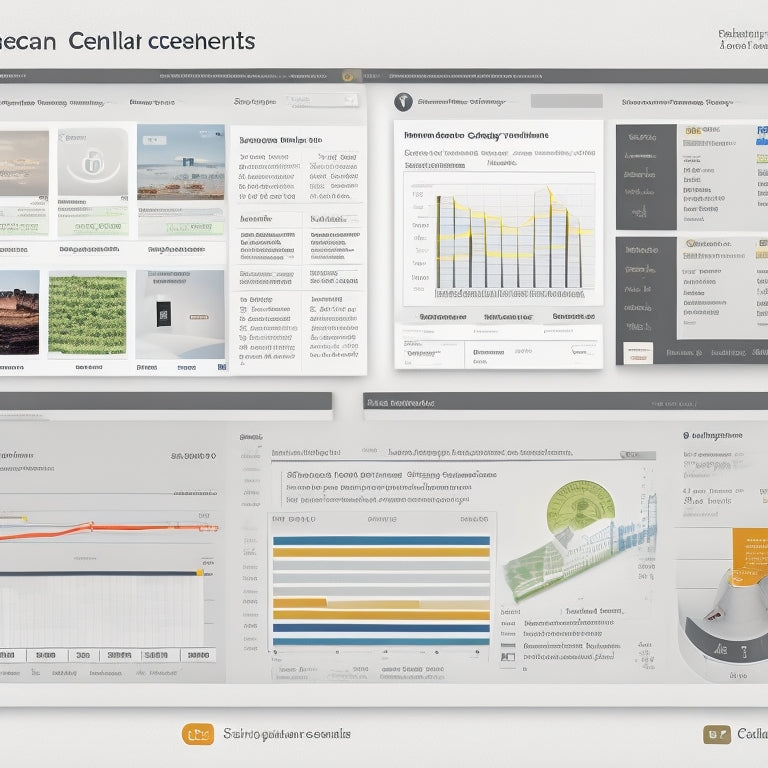
What Analytics Skills Do Online Sellers Need?
Share
You need a range of analytics skills to succeed as an online seller, including data analysis to uncover hidden opportunities, customer behavior insights to understand motivations and preferences, and measuring customer retention rates to optimize strategies. You should also be able to identify high-value customer segments, craft data-driven marketing strategies, and conduct effective A/B testing. Additionally, leveraging customer feedback data, creating personalized customer experiences, and optimizing conversion rate metrics are essential skills. By mastering these skills, you'll be able to make data-driven decisions that drive business growth - and there's even more to explore in the world of online selling analytics.
Key Takeaways
• Online sellers need data analysis skills to uncover hidden opportunities, identify market gaps, and optimize pricing, inventory, and supply chain logistics.
• They require customer behavior insights skills to uncover motivations, preferences, and areas for improvement using social media analytics and website tracking tools.
• Online sellers need to be able to measure and optimize customer retention rates by tracking and analyzing customer churn and loyalty metrics.
• They must possess skills to identify high-value customer segments using demographic analysis, behavioral targeting, and continuous refinement of customer profiles.
• Online sellers need data-driven marketing strategy skills to craft targeted marketing strategies, personalize messages, and optimize resource allocation using marketing analytics techniques.
Data Analysis for Business Growth
By leveraging data analysis, online sellers like you can uncover hidden opportunities, identify areas for improvement, and drive business growth through informed decision-making. This involves digging deep into your sales data to identify patterns, trends, and correlations that can inform your business strategy.
Conducting competitor analysis, for instance, can help you identify gaps in the market and opportunities to differentiate your brand. By analyzing market trends, you can stay ahead of the curve and adjust your product offerings or marketing strategies accordingly.
Data analysis can also help you optimize your pricing, inventory management, and supply chain logistics. With data-driven insights, you can make informed decisions to increase revenue, reduce costs, and improve operational efficiency.
Customer Behavior Insights Tools
You can tap into customer behavior insights tools to uncover the motivations and preferences driving your shoppers' purchasing decisions. These tools provide valuable data on how customers interact with your online store, helping you identify areas for improvement and opportunities for growth.
With social media analytics, you can track engagement metrics, such as likes, shares, and comments, to understand what resonates with your audience. This information allows you to refine your social media strategy and create content that drives conversions.
Website tracking tools, like Google Analytics, offer insights into on-site behavior, including bounce rates, page views, and conversion rates. This data helps you optimize your website's user experience, streamlining the path to purchase and reducing friction points.
Measuring Customer Retention Rates
Customer retention rates reveal how well your online store is meeting customers' ongoing needs, with a high rate indicating strong loyalty and a low rate signaling potential issues with your product or service offerings.
It's crucial to track this metric to identify areas for improvement and optimize your retention strategies. Calculate your customer retention rate by dividing the number of customers at the end of a period by the number at the beginning, minus any new customers acquired during that time.
A high churn rate indicates a problem, so it's crucial to monitor this metric closely. To boost customer engagement and loyalty, focus on providing exceptional customer service, offering personalized experiences, and implementing loyalty programs.
Analyze customer feedback to identify pain points and areas for improvement. By developing effective retention strategies, you can reduce churn rates and increase customer loyalty, ultimately driving revenue growth and long-term success.
Identifying High-Value Customer Segments
Segmenting your customer base into high-value groups allows you to pinpoint the most profitable relationships and develop targeted strategies to nurture and retain them. By identifying high-value customer segments, you can allocate resources more efficiently and maximize revenue.
To do this, you'll need to apply demographic analysis and behavioral targeting techniques to your customer data.
Here are 4 key steps to help you identify high-value customer segments:
-
Analyze customer demographics: Examine factors like age, location, and occupation to identify patterns and trends.
-
Utilize behavioral targeting: Use data on customer behavior, such as purchase history and browsing patterns, to create targeted groups.
-
Develop segmentation strategies: Create profiles of high-value customer segments based on their characteristics and behaviors.
- Refine customer profiling: Continuously update and refine your customer profiles to secure accuracy and relevance.
Crafting Data-Driven Marketing Strategies
With high-value customer segments identified, it's time to develop targeted marketing strategies that maximize their lifetime value, and this is where data-driven insights come into play.
You'll need to leverage marketing analytics techniques to craft strategies that resonate with each segment. This involves analyzing customer behavior, purchase history, and preferences to create personalized messages that drive engagement and conversion.
Through data-driven decision making, you'll be able to allocate resources efficiently, optimizing your marketing spend and maximizing ROI.
By analyzing customer data, you can identify patterns and trends that inform your marketing strategies, ensuring that every campaign is targeted and effective.
This includes leveraging metrics such as customer acquisition cost, retention rate, and churn rate to refine your approach and improve results over time.
Understanding Customer Lifetime Value
As an online seller, you'll want to calculate customer lifetime value to understand how much each customer is worth to your business.
By doing so, you'll be able to identify high-value segments and maximize revenue potential.
Calculating Lifetime Value
You're likely familiar with the concept of customer lifetime value, but calculating it accurately is essential to making informed decisions about customer acquisition and retention strategies. To do this, you need to understand the key components that contribute to your customers' lifetime value.
Here are the essential factors to keep in mind when calculating lifetime value:
-
Average Order Value (AOV): The average amount spent by a customer in a single transaction.
-
Purchase Frequency: The number of times a customer makes a purchase from your store within a specific timeframe.
-
Customer Lifespan: The average duration of a customer's relationship with your brand.
- Gross Margin: The profit margin on each sale, calculated by subtracting the cost of goods sold from revenue.
Identifying High-Value Segments
By analyzing customer lifetime value, you can pinpoint high-value segments within your customer base that drive the most revenue and profit for your online store. This is critical in market segmentation analysis, as it enables you to allocate resources effectively and create customer engagement strategies that resonate with your most valuable customers.
To identify these segments, you'll need to dive deeper into your customer data, examining factors such as purchase frequency, average order value, and retention rates. By doing so, you'll uncover patterns and trends that will help you identify your target audience and develop personalized marketing tactics that speak directly to their needs and preferences.
This might involve creating tailored promotions, loyalty programs, or content that resonates with your high-value segments. By targeting the right audience with the right message, you'll be able to maximize engagement, drive conversions, and ultimately, boost revenue.
Maximizing Revenue Potential
Now that you've identified your high-value segments, it's time to calculate the lifetime value of each customer to maximize revenue potential. This metric will help you understand how much each customer is worth to your business over their lifetime. By knowing this value, you can tailor your pricing strategies, inform your inventory management, and optimize your marketing efforts.
To maximize revenue potential, consider the following strategies:
-
Optimize pricing: Adjust your pricing strategies based on customer lifetime value to make sure you're maximizing revenue from each segment.
-
Conduct competitor analysis: Analyze your competitors' pricing and customer lifetime value to identify opportunities to outperform them.
-
Streamline inventory management: Use customer lifetime value to inform your inventory management, making sure you have the right products in stock to meet demand.
- Forecast trends: Use customer lifetime value to forecast trends and adjust your business strategy accordingly.
Effective A/B Testing Methods
When you're running A/B tests, it's essential to identify the winning variations and measure their impact on conversion rates. By doing so, you'll be able to pinpoint which changes drive the most significant improvements and optimize your online store accordingly.
You'll soon find that testing and refining your strategies yields significant returns on investment.
Test Winning Variations
You can greatly enhance your online sales by identifying and implementing the winning variations of your A/B tests, which involves rigorously analyzing the data to determine the most effective combinations of elements. This process helps you optimize your product performance and pricing strategies to maximize revenue. By testing different variations, you can identify which ones resonate with your target audience and drive conversions.
Here are some key steps to test winning variations:
-
Analyze data: Dive deep into your A/B test results to identify patterns and trends that indicate which variations performed better.
-
Segment your audience: Break down your audience into smaller groups to see which variations resonated with each segment.
-
Optimize for mobile: Make sure that your winning variations are optimized for mobile devices, as more and more users shop on their smartphones.
- Continuously iterate: Don't stop at one winning variation – keep testing and refining your approach to stay ahead of the competition.
Measure Conversion Impact
Measuring conversion impact is essential to effective A/B testing, as it allows you to quantify the tangible effects of your experiments on revenue, user engagement, and other key performance indicators. By analyzing the results of your tests, you can identify which variations drive the highest conversion rates and optimize your website or app accordingly.
To do this, you'll need to leverage data visualization techniques, such as heat maps and funnel analysis, to gain a deeper understanding of your customers' behavior. This will enable you to pinpoint areas of friction and optimize your customer journey for maximum conversions.
Additionally, predictive analytics applications can help you forecast the impact of future experiments, allowing you to prioritize tests with the highest potential ROI. By combining these techniques, you can access the full potential of conversion rate optimization and drive significant revenue growth.
Leveraging Customer Feedback Data
Around 80% of customers trust online reviews as much as personal recommendations, making customer feedback data a valuable resource for online sellers to pinpoint areas for improvement. You can leverage this data to refine your products, services, and overall customer experience.
To get the most out of customer feedback, you'll need to develop your skills in:
-
Sentiment analysis: Identify the emotions and opinions behind customer reviews and ratings to understand what drives customer satisfaction.
-
Feedback analysis: Categorize and prioritize feedback to identify patterns and areas for improvement.
-
Review analysis: Analyze customer reviews to identify common themes, concerns, and suggestions.
- Customer satisfaction metrics: Track metrics such as Net Promoter Score (NPS) and Customer Satisfaction (CSAT) to measure customer happiness.
Creating Personalized Customer Experiences
By leveraging customer data and analytics, online sellers can create tailored experiences that cater to individual preferences, increasing loyalty and driving repeat business. To achieve this, you'll need to develop personalization strategies that incorporate behavioral targeting.
This involves analyzing user behavior, such as browsing and purchase history, to deliver customized experiences that resonate with each customer. By doing so, you can boost user engagement, encouraging customers to return to your site and make repeat purchases.
To get started, you'll need to collect and analyze customer data from various sources, including website interactions, social media, and customer feedback. This data will help you identify patterns and preferences, enabling you to create targeted marketing campaigns and personalized product recommendations.
Additionally, you can use A/B testing to refine your personalization strategies and optimize user engagement. By harnessing the power of data analytics, you can create a loyal customer base that drives long-term revenue growth.
Optimizing Conversion Rate Metrics
When it comes to optimizing conversion rate metrics, you're likely looking to boost the percentage of visitors who complete a desired action on your site.
To start, you'll want to scrutinize your landing page design, ensuring it's intuitive and visually appealing, and reassess your call-to-action (CTA) buttons, making sure they're prominent and compelling.
Improve Landing Page Design
You can greatly improve your conversion rates by enhancing your landing page design, focusing on key elements that drive user engagement and nudge visitors towards making a purchase. A well-designed landing page is essential in today's competitive online market, as it directly impacts your conversion rates and ultimately, your revenue.
To enhance your landing page design, consider the following key elements:
-
Simplify your layout: A cluttered design can overwhelm visitors, leading to high bounce rates. Ensure a clean and minimalistic layout that guides visitors' attention to your call-to-action.
-
Use high-quality visual elements: High-quality images and videos can improve user experience, making your product more appealing and increasing the chances of conversion.
-
Optimize for mobile: With most users accessing your site through mobile devices, ensure a responsive design that provides an ideal user experience across all devices.
- Use social proof: Customer testimonials, ratings, and reviews can build trust and credibility, increasing the likelihood of conversion.
Enhance Call-to-Action Buttons
Enhancing your call-to-action (CTA) buttons is crucial, as even slight adjustments can produce notable enhancements in conversion rates, with studies indicating that strategically crafted CTAs can increase conversions by up to 25%.
To maximize the impact, you need to concentrate on button design elements that boost conversions. Start by using action-driven language on your CTAs, such as 'Buy Now' or 'Get Started,' instead of generic phrases like 'Submit' or 'Click Here.'
Also, make sure your CTAs are prominently displayed, using contrasting colors to make them stand out from the rest of the page. Don't underestimate the power of whitespace – surround your CTAs with ample padding to draw attention to them.
Lastly, test different button shapes, sizes, and styles to discover the best combination that resonates with your target audience. By applying these conversion enhancement strategies, you can notably enhance your conversion rates and drive more sales.
Frequently Asked Questions
How Do I Balance Analytics With Intuition in Business Decision-Making?
You balance intuition with data analysis by combining gut feelings with hard metrics, weighing pros and cons, and using decision making strategies like cost-benefit analysis to guarantee informed, data-driven choices.
Can I Use Analytics Tools Without Prior Data Analysis Experience?
You can still leverage analytics tools without prior data analysis experience; invest in analytics training to grasp fundamentals, then focus on practical applications, and you'll be making data-driven decisions in no time.
What Is the Ideal Frequency for Reviewing Analytics Data?
You're the captain of your online ship, and reviewing analytics data is your navigational chart. Aim to check in weekly, like a pit stop, to guarantee data driven decision making and tracking success, with consistent monitoring to adjust strategies and stay on course.
How Do I Ensure Data Quality and Accuracy in My Analytics?
You guarantee data quality and accuracy by implementing robust data validation processes, preventing errors through automated checks, and regularly auditing your analytics setup to catch discrepancies, guaranteeing reliable insights to inform your business decisions.
Are There Any Free or Low-Cost Analytics Tools for Small Sellers?
You can leverage free or low-cost analytics tools like Google Data Studio for data visualization and Google Analytics for performance tracking to gain valuable insights without breaking the bank.
Related Posts
-
How Can I Optimize My Videos for Seo on Shopify?
In today's digital landscape, optimizing videos for SEO on Shopify has become crucial for businesses looking to incr...
-

Why Ecommerce Sites Need Product Download Analytics
You're leaving money on the table if you're not monitoring product downloads on your ecommerce site. Without product ...
-

How Does the Shopify Blog Work
This article aims to provide an informative overview of the workings of the Shopify blog. The Shopify blog functions...

